Soil Nutrient Monitoring Technologies for Sustainable Agriculture: A Systematic Review
Abstract
1. Introduction
- Analyze the spatial and temporal patterns of relevant scientific publications, providing insights into geographic focus and the evolving research trends.
- Synthesize definitions from diverse studies to establish a clear and unified understanding of soil nutrient monitoring.
- Assess the available monitoring technologies, evaluating their strengths and limitations.
- Identify and classify different sensor technologies utilized in soil nutrient monitoring, detailing the specific types of nutrients each technology detects.
- Analyze the input and output data utilized by AI technology in soil nutrient analysis.
- Investigate validation and accuracy approaches of monitoring technologies.
- Describe soil nutrient sampling protocols, including sampling frequency and locations.
- Address the criteria used in selecting suitable monitoring sites.
2. Materials and Methods
2.1. Framework Adoption and Article Selection Process
2.2. Quality Assessment and Study Selection Process
2.3. Data Extraction and Analysis
3. Results
3.1. Temporal and Spatial Distribution of Studies
3.2. Soil Nutrient Monitoring Definition
3.3. Soil Nutrient Monitoring Technologies
3.3.1. Traditional Methods
3.3.2. Remote Sensing
3.3.3. Internet of Things (IoT) and Smart Systems
3.3.4. Sensors
- (I)
- Electrochemical sensors
- (II)
- Biosensors
- (III)
- Optical Sensors
- (IV)
- Wireless Sensors
3.3.5. Artificial Intelligence Applications
3.4. Validation and Accuracy Techniques
3.5. Soil Nutrient Sampling Practices
3.6. Criteria for Selecting Monitoring Sites
4. Discussion
4.1. Definition Challenges
4.2. Technological Evolution and Nutrient Management
4.3. Soil Nutrients Monitoring and Sustainability
4.4. Assumptions, Limitations, and Challenges
5. Conclusions
Supplementary Materials
Author Contributions
Funding
Institutional Review Board Statement
Informed Consent Statement
Data Availability Statement
Acknowledgments
Conflicts of Interest
References
- Shah, F.; Wu, W. Soil and crop management strategies to ensure higher crop productivity within sustainable environments. Sustainability 2019, 11, 1485. [Google Scholar] [CrossRef]
- Issaka, F.; Zhang, Z.; Zhao, Z.-Q.; Asenso, E.; Li, J.-H.; Li, Y.-T.; Wang, J.-J. Sustainable conservation tillage improves soil nutrients and reduces nitrogen and phosphorous losses in maize farmland in Southern China. Sustainability 2019, 11, 2397. [Google Scholar] [CrossRef]
- He, J.; Dai, Q.; Yi, X.; Wang, Y.; Peng, X.; Yan, Y. Soil water retention modulates effects of soil nutrients and stoichiometry on stability of organic carbon in a karst region, Southwestern China. Plant Soil 2023, 489, 557–572. [Google Scholar] [CrossRef]
- Telo da Gama, J. The role of soils in sustainability, climate change, and ecosystem services: Challenges and opportunities. Ecologies 2023, 4, 552–567. [Google Scholar] [CrossRef]
- Van Sundert, K.; Radujković, D.; Cools, N.; De Vos, B.; Etzold, S.; Fernández-Martínez, M.; Janssens, I.A.; Merilä, P.; Peñuelas, J.; Sardans, J. Towards comparable assessment of the soil nutrient status across scales—Review and development of nutrient metrics. Glob. Change Biol. 2020, 26, 392–409. [Google Scholar] [CrossRef] [PubMed]
- Țopa, D.-C.; Căpșună, S.; Calistru, A.-E.; Ailincăi, C. Sustainable Practices for Enhancing Soil Health and Crop Quality in Modern Agriculture: A Review. Agriculture 2025, 15, 998. [Google Scholar] [CrossRef]
- Kashyap, B.; Kumar, R. Sensing methodologies in agriculture for soil moisture and nutrient monitoring. IEEE Access 2021, 9, 14095–14121. [Google Scholar] [CrossRef]
- Li, T.; Cui, L.; Filipović, V.; Tang, C.; Lai, Y.; Wehr, B.; Song, X.; Chapman, S.; Liu, H.; Dalal, R.C. From soil health to agricultural productivity: The critical role of soil constraint management. Catena 2025, 250, 108776. [Google Scholar] [CrossRef]
- Jain, S.; Sethia, D.; Tiwari, K.C. A critical systematic review on spectral-based soil nutrient prediction using machine learning. Environ. Monit. Assess. 2024, 196, 699. [Google Scholar] [CrossRef]
- Xu, X.; Xiao, C.; Dong, Y.; Zhan, L.; Bi, R.; Song, M.; Pan, J.; Xiong, Z. Machine learning algorithms realized soil stoichiometry prediction and its driver identification in intensive agroecosystems across a north-south transect of eastern China. Sci. Total Environ. 2024, 906, 167488. [Google Scholar] [CrossRef]
- Wang, W.; Zhang, Y.; Li, Z.; Liu, Q.; Feng, W.; Chen, Y.; Jiang, H.; Liang, H.; Chang, N. Fourier-Transform Infrared Spectral Inversion of Soil Available Potassium Content Based on Different Dimensionality Reduction Algorithms. Agronomy 2023, 13, 617. [Google Scholar] [CrossRef]
- Shokirov, S.; Abdurahmanov, I.; Mamatkulov, Z.; Abdurahmanov, Z.; Zarifboev, D.; Oymatov, R.; Kovács, Z.; Csabai, J.; Shiping, Y.; Khakberdiev, O. Leveraging Vegetation Indices and Random Forest for Soil Nutrient Monitoring in Winter Wheat. J. Indian Soc. Remote Sens. 2025, 1–11. [Google Scholar] [CrossRef]
- Akhil, R.; Gokul, M.; Menon, S.; Nair, L.S. Automated soil nutrient monitoring for improved agriculture. In Proceedings of the 2018 International Conference on Communication and Signal Processing (ICCSP), Chennai, India, 3–5 April 2018; pp. 0688–0692. [Google Scholar]
- Abay, K.A.; Abay, M.H.; Amare, M.; Berhane, G.; Aynekulu, E. Mismatch between soil nutrient deficiencies and fertilizer applications: Implications for yield responses in Ethiopia. Agric. Econ. 2022, 53, 215–230. [Google Scholar] [CrossRef]
- Malde, H.; Masekar, M.; Panchal, D.; Walvekar, P. Automatic Plant Monitoring and Control System. Int. Res. J. Eng. Technol. (IRJET) 2020, 7, 6269–6273. [Google Scholar]
- Airee, S.; Mukherjee, A. Impacts of farming management on soil health and water quality in Kentucky. Agrosystems Geosci. Environ. 2025, 8, e70134. [Google Scholar] [CrossRef]
- Anandhi, A.; Book, R.; Ozbay, G. A Novel Framework to Represent Hypoxia in Coastal Systems. Land 2025, 14, 1169. [Google Scholar] [CrossRef]
- Xing, Y.; Wang, X. Impact of agricultural activities on climate change: A review of greenhouse gas emission patterns in field crop systems. Plants 2024, 13, 2285. [Google Scholar] [CrossRef]
- Mohapatra, A.G.; Lenka, S.K. Sensor system technology for soil parameter sensing in precision agriculture: A review. J. Agric. Phys. 2015, 15, 181–202. [Google Scholar]
- Burton, L.; Jayachandran, K.; Bhansali, S. The “Real-Time” revolution for in situ soil nutrient sensing. J. Electrochem. Soc. 2020, 167, 037569. [Google Scholar] [CrossRef]
- Nadporozhskaya, M.; Kovsh, N.; Paolesse, R.; Lvova, L. Recent advances in chemical sensors for soil analysis: A review. Chemosensors 2022, 10, 35. [Google Scholar] [CrossRef]
- Yadav, A.; Yadav, K.; Ahmad, R.; Abd-Elsalam, K.A. Emerging frontiers in nanotechnology for precision agriculture: Advancements, hurdles and prospects. Agrochemicals 2023, 2, 220–256. [Google Scholar] [CrossRef]
- Fan, Y.; Wang, X.; Funk, T.; Rashid, I.; Herman, B.; Bompoti, N.; Mahmud, M.S.; Chrysochoou, M.; Yang, M.; Vadas, T.M. A critical review for real-time continuous soil monitoring: Advantages, challenges, and perspectives. Environ. Sci. Technol. 2022, 56, 13546–13564. [Google Scholar] [CrossRef]
- Abdulraheem, M.I.; Zhang, W.; Li, S.; Moshayedi, A.J.; Farooque, A.A.; Hu, J. Advancement of remote sensing for soil measurements and applications: A comprehensive review. Sustainability 2023, 15, 15444. [Google Scholar] [CrossRef]
- Chen, K.-Y.; Kachhadiya, J.; Muhtasim, S.; Cai, S.; Huang, J.; Andrews, J. Underground ink: Printed electronics enabling electrochemical sensing in soil. Micromachines 2024, 15, 625. [Google Scholar] [CrossRef]
- Dattatreya, S.; Khan, A.N.; Jena, K.; Chatterjee, G. Conventional to modern methods of soil npk sensing: A review. IEEE Sens. J. 2023, 24, 2367–2380. [Google Scholar] [CrossRef]
- Ameer, S.; Ibrahim, H.; Kulsoom, F.; Ameer, G.; Sher, M. Real-time detection and measurements of nitrogen, phosphorous & potassium from soil samples: A comprehensive review. J. Soils Sediments 2024, 24, 2565–2583. [Google Scholar] [CrossRef]
- Avhad, K.; Mahajan, D.; Kharat, I.; Jadhav, S.; Chattopadhyay, M.M. Soil Nutrients Analysis Techniques and Crop/Fertilizers Prediction—A Review. Int. J. Eng. Res. Technol 2022, 11, 12. [Google Scholar]
- Mhoro, L.; Meya, A.I.; Amuri, N.A.; Ndakidemi, P.A.; Mtei, K.M.; Njau, K.N. Influence of farmers’ socio-economic characteristics on nutrient flow and implications for system sustainability in smallholdings: A review. Front. Soil Sci. 2023, 3, 1112629. [Google Scholar] [CrossRef]
- Kumar, B.; Negi, H.S.; Rawat, V.; Badola, S.K. Wireless sensor network and iot-based crop and soil quality analysis for smart farming: Opportunities and challenges. Ilkogr. Online 2021, 20, 3932–3944. [Google Scholar]
- Ndjuluwa, L.N.; Adebisi, J.A.; Dayoub, M. Internet of things for crop farming: A review of technologies and applications. Commodities 2023, 2, 367–381. [Google Scholar] [CrossRef]
- Musa, P.; Sugeru, H.; Wibowo, E.P. Wireless sensor networks for precision agriculture: A review of npk sensor implementations. Sensors 2023, 24, 51. [Google Scholar] [CrossRef] [PubMed]
- Google Scholar Database. Available online: https://scholar.google.com/ (accessed on 11 August 2024).
- Map Chart. Available online: https://www.mapchart.net/world.html (accessed on 15 April 2025).
- Mamman, S.I.; Lubega, J.B. The integration of Internet of Things (IoT) and soil nutrients monitoring to enhance organic farming: A case study of Casad Enterprise Farm. J. Innov. Technol. Bus. Sustain. Dev. 2022, 4. [Google Scholar]
- Zu, D.; Su, Z.; Yang, X.; Gu, X.; Wang, Y. Design and Implementation of Soil Nutrient Monitoring System Based on “3S” Technology. Int. J. Smart Home 2015, 9, 153–164. [Google Scholar] [CrossRef]
- Ai, X.; Tian, X.; Yang, S.; Ai, S.; Jiang, X.; Sheng, M.; Ai, Y. Time-dependent effects of ecological rehabilitation on soil phosphorus fractions on cut slopes in the mountains of Southwest China. Land Degrad. Dev. 2023, 34, 3539–3549. [Google Scholar] [CrossRef]
- Gourley, C.J.; Weaver, D.M.; Simpson, R.J.; Aarons, S.R.; Hannah, M.M.; Peverill, K.I. The development and application of functions describing pasture yield responses to phosphorus, potassium and sulfur in Australia using meta-data analysis and derived soil-test calibration relationships. Crop Pasture Sci. 2019, 70, 1065–1079. [Google Scholar] [CrossRef]
- Mesfin, S.; Gebresamuel, G.; Zenebe, A.; Haile, M. Nutrient balances in smallholder farms in northern Ethiopia. Soil Use Manag. 2021, 37, 468–478. [Google Scholar] [CrossRef]
- Montañez, J.F. Optimizing the Detection of Soil Nitrogen Levels via Grayscale Conversion: A Full-Factorial Design of Experiment Approach. Int. J. Comput. Digit. Syst. 2024, 17, 1–10. [Google Scholar]
- Chojnacka, K. Sustainable chemistry in adaptive agriculture: A review. Curr. Opin. Green Sustain. Chem. 2024, 46, 100898. [Google Scholar] [CrossRef]
- Pratama, A.; Rahayu, S. Biosensors enabled by nanotechnology: Advancing precision agriculture through IoT monitoring. J. Intell. Connect. Emerg. Technol. 2024, 9, 25–39. [Google Scholar]
- Xu, Z.; Wang, X.; Weber, R.J.; Kumar, R.; Dong, L. Nutrient sensing using chip scale electrophoresis and in situ soil solution extraction. IEEE Sens. J. 2017, 17, 4330–4339. [Google Scholar] [CrossRef]
- Zhang, J.; Wei, Q.; Xiong, S.; Shi, L.; Ma, X.; Du, P.; Guo, J. A spectral parameter for the estimation of soil total nitrogen and nitrate nitrogen of winter wheat growth period. Soil Use Manag. 2020, 37, 698–711. [Google Scholar] [CrossRef]
- Liu, Z.; Lei, H.; Lei, L.; Sheng, H. Spatial prediction of total nitrogen in soil surface layer based on machine learning. Sustainability 2022, 14, 11998. [Google Scholar] [CrossRef]
- Fan, Y.; Wang, X.; Qian, X.; Dixit, A.; Herman, B.; Lei, Y.; McCutcheon, J.; Li, B. Enhancing the understanding of soil nitrogen fate using a 3D-electrospray sensor roll casted with a thin-layer hydrogel. Environ. Sci. Technol. 2022, 56, 4905–4914. [Google Scholar] [CrossRef]
- Johnson, D.W.; Walker, R.F.; Glass, D.W.; Stein, C.M.; Murphy, J.B.; Blank, R.R.; Miller, W.W. Effects of thinning, residue mastication, and prescribed fire on soil and nutrient budgets in a Sierra Nevada mixed-conifer forest. For. Sci. 2014, 60, 170–179. [Google Scholar] [CrossRef]
- Braunger, M.L.; Neto, M.P.; Kirsanov, D.; Fier, I.; Amaral, L.R.; Shimizu, F.M.; Correa, D.S.; Paulovich, F.V.; Legin, A.; Oliveira, O.N., Jr. Analysis of macronutrients in soil using impedimetric multisensor arrays. ACS Omega 2024, 9, 33949–33958. [Google Scholar] [CrossRef] [PubMed]
- Archana, A.; Sankari, V.S.; Nair, S.S. An economically mobile device for the on-site testing of soil nutrients by studying the spectrum. Mater. Today Proc. 2023, 80, 1826–1829. [Google Scholar]
- Zhang, J.; Ji, D.; Du, D.; Miao, J.; Liu, H.; Bai, Y. Temporal paradox in soil potassium estimations using spaceborne multispectral imagery. Catena 2020, 194, 104771. [Google Scholar] [CrossRef]
- Johnson, D.L.; Ambrose, S.H.; Bassett, T.J.; Bowen, M.L.; Crummey, D.E.; Isaacson, J.S.; Johnson, D.N.; Lamb, P.; Saul, M.; Winter-Nelson, A.E. Meanings of environmental terms. J. Environ. Qual. 1997, 26, 581–589. [Google Scholar] [CrossRef]
- Cheng, Z.; Meng, J.; Shang, J.; Liu, J.; Qiao, Y.; Qian, B.; Jing, Q.; Dong, T. Improving soil available nutrient estimation by integrating modified WOFOST model and time-series earth observations. IEEE Trans. Geosci. Remote Sens. 2018, 57, 2896–2908. [Google Scholar]
- Hossain, M.D.; Kashem, M.A.; Mustary, S. Iot based smart soil fertilizer monitoring and ml based crop recommendation system. In Proceedings of the 2023 International Conference on Electrical, Computer and Communication Engineering (ECCE), Chittagong, Bangladesh, 23–25 February 2023; pp. 1–6. [Google Scholar]
- Kasera, R.K.; Gour, S.; Acharjee, T. A comprehensive survey on IoT and AI based applications in different pre-harvest, during-harvest and post-harvest activities of smart agriculture. Comput. Electron. Agric. 2024, 216, 108522. [Google Scholar] [CrossRef]
- Li, M.; Zhao-Hong, B.; Yong-Hong, W.; Li-Zhong, X.; Lin-Zhang, Y. An integrated quantitative method to simultaneously monitor soil erosion and non-point source pollution in an intensive agricultural area. Pedosphere 2014, 24, 674–682. [Google Scholar] [CrossRef]
- Mbibueh, B.T.; Fokeng, R.M.; Tume, S.J. Effects of land Cover/Use change and altitude on soil NPK nutrients in selected areas in the north West region of Cameroon. Adv. Environ. Eng. Res. 2021, 2, 38. [Google Scholar] [CrossRef]
- Guzman, C.D.; Tilahun, S.A.; Dagnew, D.C.; Zimale, F.A.; Zegeye, A.D.; Boll, J.; Parlange, J.-Y.; Steenhuis, T.S. Spatio-temporal patterns of groundwater depths and soil nutrients in a small watershed in the Ethiopian highlands: Topographic and land-use controls. J. Hydrol. 2017, 555, 420–434. [Google Scholar]
- Zhang, Y.; Peng, Z.; Chang, S.; Wang, Z.; Li, D.; An, Y.; Hou, F.; Ren, J. Growing season grazing promotes the shallow stratification of soil nutrients while non-growing season grazing sequesters the deep soil nutrients in a typical alpine meadow. Geoderma 2022, 426, 116111. [Google Scholar] [CrossRef]
- Mbibueh, B.T.; Fokeng, R.M.; Tellen, V.A.; Tawe, I.T. Land use and topographic controls on soil chemical properties in some selected sites of the north west region of Cameroon. Geol. Ecol. Landsc. 2024, 9, 753–774. [Google Scholar]
- Pan, J.; Guo, Q.; Li, H.; Luo, S.; Zhang, Y.; Yao, S.; Fan, X.; Sun, X.; Qi, Y. Dynamics of soil nutrients, microbial community structure, enzymatic activity, and their relationships along a chronosequence of Pinus massoniana plantations. Forests 2021, 12, 376. [Google Scholar] [CrossRef]
- He, Y.; Yao, Y.; Shi, S.; Chen, Y.; Li, J.; Xiao, B. Study on impact evaluation of regional arable land change on food crops productivity. In Proceedings of the 2011 Fourth International Conference on Intelligent Computation Technology and Automation, Shenzhen, China, 28–29 March 2011; pp. 207–223. [Google Scholar]
- Bayih, A.Z.; Morales, J.; Assabie, Y.; De By, R.A. Utilization of internet of things and wireless sensor networks for sustainable smallholder agriculture. Sensors 2022, 22, 3273. [Google Scholar] [CrossRef]
- Ardiansyah, D.; Huda, A.S.M.; Tosida, E.T.; Bon, A.T. Wireless sensor networks for soil nutrition to increase agricultural productivity. In Proceedings of the 5th NA International Conference on Industrial Engineering and Operations Management, Detroit, MI, USA, 10–14 August 2020. [Google Scholar]
- Babu, S.; Madhusudanan, S.; Sathiyanarayanan, M.; Mortka, M.Z.; Szymański, J.; Rahul, R. Soil mapping for farming productivity: Internet of things (IoT) based sustainable agriculture. Microsyst. Technol. 2024, 31, 679–694. [Google Scholar] [CrossRef]
- Hartono, R.; Yoeseph, N.M.; Purnomo, F.A.; Safi’ie, M.A.; Bawono, S.A.T. Portable internet of things-based soil nutrients monitoring for precision and efficient smart farming. Bull. Electr. Eng. Inform. 2024, 13, 3326–3333. [Google Scholar] [CrossRef]
- Babar, A.Z.; Akan, O.B. Sustainable and precision agriculture with the internet of everything (IoE). arXiv 2024, arXiv:2404.06341. [Google Scholar] [CrossRef]
- Ghadge, S.V.; Devale, P.; Deshmukh, S.; Shah, S.; Gadhave, G.; Pawar, S.; Swapnali, L. The Smart Agriculture System Using IOT and ML. Electr. Syst. 2024, 20. [Google Scholar] [CrossRef]
- Hasan, M.; Manohar, S. IoT based site specific nutrient management system. ICONIC Res. Eng. J 2022, 5, 396–401. [Google Scholar]
- Jose, R.; Thomas, N. Smart farming via iot: A solution for monitoring rice productions. Int. J. Creat. Res. Thoughts (IJCRT) 2021, 9, 2320–2882. [Google Scholar]
- Prasad, R.; Tiwari, R.; Srivastava, A.K. Internet of Things-based fuzzy logic controller for smart soil health monitoring: A case study of semi-arid regions of India. Eng. Proc. 2023, 58, 85. [Google Scholar]
- Amado, T.M.; Alvarez, A.E.D.; Ocampo, A.; Paz, V.A.F.; Punongbayan, A.J.N.; Padilla, M.V.C.; Madrigal, G.A.M.; Tolentino, L.K.S.; Monilar, E.G. Development of an IoT-Based Soil Macronutrient Analysis System Utilizing Electrochemical Sensors and Machine Learning Algorithms. In Proceedings of the 2023 International Conference on Network, Multimedia and Information Technology (NMITCON), Bengaluru, India, 1–2 September 2023; pp. 1–6. [Google Scholar]
- Weerasinghe, W.; Goonatilleke, M.; Prasadi, W.; Chandrasiri, S.; Jayathilake, K.; Mahaadikara, H. Smart Monitoring System for Optimization of Tea Plantation. In Proceedings of the 2023 International Conference on Innovative Computing, Intelligent Communication and Smart Electrical Systems (ICSES), Chennai, India, 14–15 December 2023; pp. 1–7. [Google Scholar]
- Rajasekaran, C.; Jeeva, R.; Hariharan, R.; Jeevanantham, M.; Jayanthi, K.; Raguvaran, K. An Integrating IoT for Intelligent Soil Analysis and Crop Optimization. In Proceedings of the 2024 2nd International Conference on Artificial Intelligence and Machine Learning Applications Theme: Healthcare and Internet of Things (AIMLA), Namakkal, India, 15–16 March 2024; pp. 1–4. [Google Scholar]
- Pallavi, C.; Usha, S. IoT based site specific nutrient management system for soil health monitoring. In Proceedings of the 2022 International Conference on Smart and Sustainable Technologies in Energy and Power Sectors (SSTEPS), Mahendragarh, India, 7–11 November 2022; pp. 166–170. [Google Scholar]
- Maiwald, M.; Sowoidnich, K.; Sumpf, B. Portable shifted excitation Raman difference spectroscopy for on-site soil analysis. J. Raman Spectrosc. 2022, 53, 1560–1570. [Google Scholar] [CrossRef]
- Agron, D.J.S.; Kim, W.S. 3D printing technology: Role in safeguarding food security. Anal. Chem. 2024, 96, 4333–4342. [Google Scholar] [CrossRef] [PubMed]
- Baumbauer, C.L.; Goodrich, P.J.; Payne, M.E.; Anthony, T.; Beckstoffer, C.; Toor, A.; Silver, W.; Arias, A.C. Printed potentiometric nitrate sensors for use in soil. Sensors 2022, 22, 4095. [Google Scholar] [CrossRef]
- Domenicano, S.; Coll, L.; Messier, C.; Berninger, F. Nitrogen forms affect root structure and water uptake in the hybrid poplar. New For. 2011, 42, 347–362. [Google Scholar] [CrossRef]
- Jin, X.; Saha, A.; Jiang, H.; Oduncu, M.R.; Yang, Q.; Sedaghat, S.; Maize, K.; Allebach, J.P.; Shakouri, A.; Glassmaker, N. Steady-state and transient performance of ion-sensitive electrodes suitable for wearable and implantable electro-chemical sensing. IEEE Trans. Biomed. Eng. 2021, 69, 96–107. [Google Scholar] [CrossRef]
- Joly, M.; Mazenq, L.; Marlet, M.; Temple-Boyer, P.; Durieu, C.; Launay, J. All-solid-state multimodal probe based on ISFET electrochemical microsensors for in-situ soil nutrients monitoring in agriculture. In Proceedings of the 2017 19th International Conference on Solid-State Sensors, Actuators and Microsystems (TRANSDUCERS), Kaohsiung, Taiwan, 18–22 June 2017; pp. 222–225. [Google Scholar]
- Kumar, A.; Kanthi, S.; Vinaykumar, M.; Hemanth, M.; Hemanth, P. A Systematic Exploration of Sensor-Based Approaches for Soil Nutrient Monitoring and Optimization. In Proceedings of the 2023 3rd International Conference on Mobile Networks and Wireless Communications (ICMNWC), Tumkur, India, 4–5 December 2023; pp. 1–6. [Google Scholar]
- Lehmann, U.; Grisel, A. Miniature multisensor probe for soil nutrient monitoring. Procedia Eng. 2014, 87, 1429–1432. [Google Scholar] [CrossRef]
- Liu, K.; Zhang, Y.; Gao, T.; Tong, F.; Liu, P.; Li, W.; Li, M. A handheld rapid detector of soil total nitrogen based on phase-locked amplification technology. Comput. Electron. Agric. 2024, 224, 109233. [Google Scholar] [CrossRef]
- Mai, Y.; Ghiasvand, A.; Gupta, V.; Edwards, S.; Cahoon, S.; Debruille, K.; Mikhail, I.; Murray, E.; Paull, B. Application of a portable ion chromatograph for real-time field analysis of nitrite and nitrate in soils and soil pore waters. Talanta 2024, 274, 126031. [Google Scholar] [CrossRef] [PubMed]
- Padhiary, M.; Kyndiah, A.; Kumar, R.; Saha, D. Exploration of electrode materials for in-situ soil fertilizer concentration measurement by electrochemical method. Int. J. Adv. Biochem. Res 2024, 8, 539–544. [Google Scholar] [CrossRef]
- Rekha, V.S.D.; Haritha, T.; Devi, S.R.; Avinash, P.; Srinivas, V. Employing Industry 4.0 to Supervise Soil Supplements and Estimate its Content. In Proceedings of the 2023 7th International Conference on Computing Methodologies and Communication (ICCMC), Erode, India, 23–25 February 2023; pp. 1553–1559. [Google Scholar]
- Riedel, V.; Hinck, S.; Peiter, E.; Ruckelshausen, A. Concept and Realisation of ISFET-Based Measurement Modules for Infield Soil Nutrient Analysis and Hydroponic Systems. Electronics 2024, 13, 2449. [Google Scholar] [CrossRef]
- Schell, E.V.; Murphy, J.G.; Hawkings, J.R.; Plante, A.F.; Allen, M.G. Degradable Mo-Based Phosphate Sensor for In-Soil Agricultural Monitoring. In Proceedings of the 2023 IEEE SENSORS, Vienna, Austria, 29 October–1 November 2023; pp. 1–4. [Google Scholar]
- Stroobosscher, Z.J.; Athelly, A.; Guzmán, S.M. Assessing capacitance soil moisture sensor probes’ ability to sense nitrogen, phosphorus, and potassium using volumetric ion content. Front. Agron. 2024, 6, 1346946. [Google Scholar] [CrossRef]
- Tharini, C.; Iyappan, G.; Manikandan, E.; Sephra, P.J. Potentiometric sensing of potassium ion (K+) using valinomycin supported on ZnO/rGO nanocomposites. J. Mater. Sci. Mater. Electron. 2023, 34, 1474. [Google Scholar] [CrossRef]
- Cai, H.-T.; Liu, J.; Chen, J.-Y.; Zhou, K.-H.; Pi, J.; Xia, L.-R. Soil nutrient information extraction model based on transfer learning and near infrared spectroscopy. Alex. Eng. J. 2021, 60, 2741–2746. [Google Scholar] [CrossRef]
- Lei, T.; Guo, X.; Sun, X.; Ma, J.; Zhang, S.; Zhang, Y. Prediction of soil urea conversion and quantification of the importance degrees of influencing factors through a new combinatorial model based on cluster method and artificial neural network. Chemosphere 2018, 199, 676–683. [Google Scholar] [CrossRef]
- Mehta, M.; Saha, A.; Fulia, S.; Jain, T.; Shekokar, N. An Innovative Model For Soil Testing With Intelligent Crop Recommendation System. In Proceedings of the 2023 14th International Conference on Computing Communication and Networking Technologies (ICCCNT), Delhi, India, 6–8 July 2023; pp. 1–6. [Google Scholar]
- Wang, H.; Zhang, L.; Zhao, J.; Hu, X.; Ma, X. Application of hyperspectral technology combined with bat algorithm-AdaBoost model in field soil nutrient prediction. Ieee Access 2022, 10, 100286–100299. [Google Scholar] [CrossRef]
- Yudhana, A.; Cahyo, A.D.; Sabila, L.Y.; Subrata, A.C.; Mufandi, I. Spatial distribution of soil nutrient content for sustainable rice agriculture using geographic information system and Naïve Bayes classifier. Int. J. Smart Sens. Intell. Syst. 2023, 16, 1–14. [Google Scholar] [CrossRef]
- Chen, M.; Zhang, M.; Wang, X.; Yang, Q.; Wang, M.; Liu, G.; Yao, L. An all-solid-state nitrate ion-selective electrode with nanohybrids composite films for in-situ soil nutrient monitoring. Sensors 2020, 20, 2270. [Google Scholar] [CrossRef]
- Brophy, S. Mycorrhizal propagule densities and soil properties across varying burn severities, three years post-fire, in warm/dry mixed conifer forest in the 416 Fire, southwest Colorado, USA. Metamorphosis 2022. [Google Scholar]
- Chaudhari, B.; Patil, V.N.; Patil, J. GPS-GIS-Based Soil Fertility Maps of Shahada Tahsil of Nandurbar District (MS). Biol. Life Sci. Forum 2022, 16, 19. [Google Scholar]
- Lindsay, E.A.; French, K. Litterfall and nitrogen cycling following invasion by Chrysanthemoides monilifera ssp. rotundata in coastal Australia. J. Appl. Ecol. 2005, 42, 556–566. [Google Scholar] [CrossRef]
- Miller, T.; Mikiciuk, G.; Durlik, I.; Mikiciuk, M.; Łobodzińska, A.; Śnieg, M. The IoT and AI in Agriculture: The Time Is Now—A Systematic Review of Smart Sensing Technologies. Sensors 2025, 25, 3583. [Google Scholar] [CrossRef]
- Karunathilake, E.; Le, A.T.; Heo, S.; Chung, Y.S.; Mansoor, S. The path to smart farming: Innovations and opportunities in precision agriculture. Agriculture 2023, 13, 1593. [Google Scholar] [CrossRef]
- Maharajan, T.; Ceasar, S.A.; Krishna, T.P.A.; Ignacimuthu, S. Management of phosphorus nutrient amid climate change for sustainable agriculture. J. Environ. Qual. 2021, 50, 1303–1324. [Google Scholar] [CrossRef] [PubMed]
- Gomiero, T. Soil degradation, land scarcity and food security: Reviewing a complex challenge. Sustainability 2016, 8, 281. [Google Scholar] [CrossRef]
- Handayani, I.; Hale, C. Healthy soils for productivity and sustainable development in agriculture. IOP Conf. Ser. Earth Environ. Sci. 2022, 1018, 012038. [Google Scholar] [CrossRef]
- Bonfante, A.; Basile, A.; Bouma, J. Targeting the soil quality and soil health concepts when aiming for the United Nations Sustainable Development Goals and the EU Green Deal. Soil 2020, 6, 453–466. [Google Scholar] [CrossRef]
- Yin, C.; Zhao, W.; Pereira, P. Soil conservation service underpins sustainable development goals. Glob. Ecol. Conserv. 2022, 33, e01974. [Google Scholar] [CrossRef]
- Bhamini, K.; Kumar, A.; Magrey, A.H.; Kulsoom, S. The role of GIS and GPS in precision fertilization: Optimizing nutrient management for sustainable cropping. Int. J. Res. Agron. 2025, 8, 260–267. [Google Scholar] [CrossRef]
- Page, M.J.; McKenzie, J.E.; Bossuyt, P.M.; Boutron, I.; Hoffmann, T.C.; Mulrow, C.D.; Shamseer, L.; Tetzlaff, J.M.; Akl, E.A.; Brennan, S.E.; et al. The PRISMA 2020 statement: An updated guideline for reporting systematic reviews. BMJ 2021, 372, n71. [Google Scholar] [CrossRef]
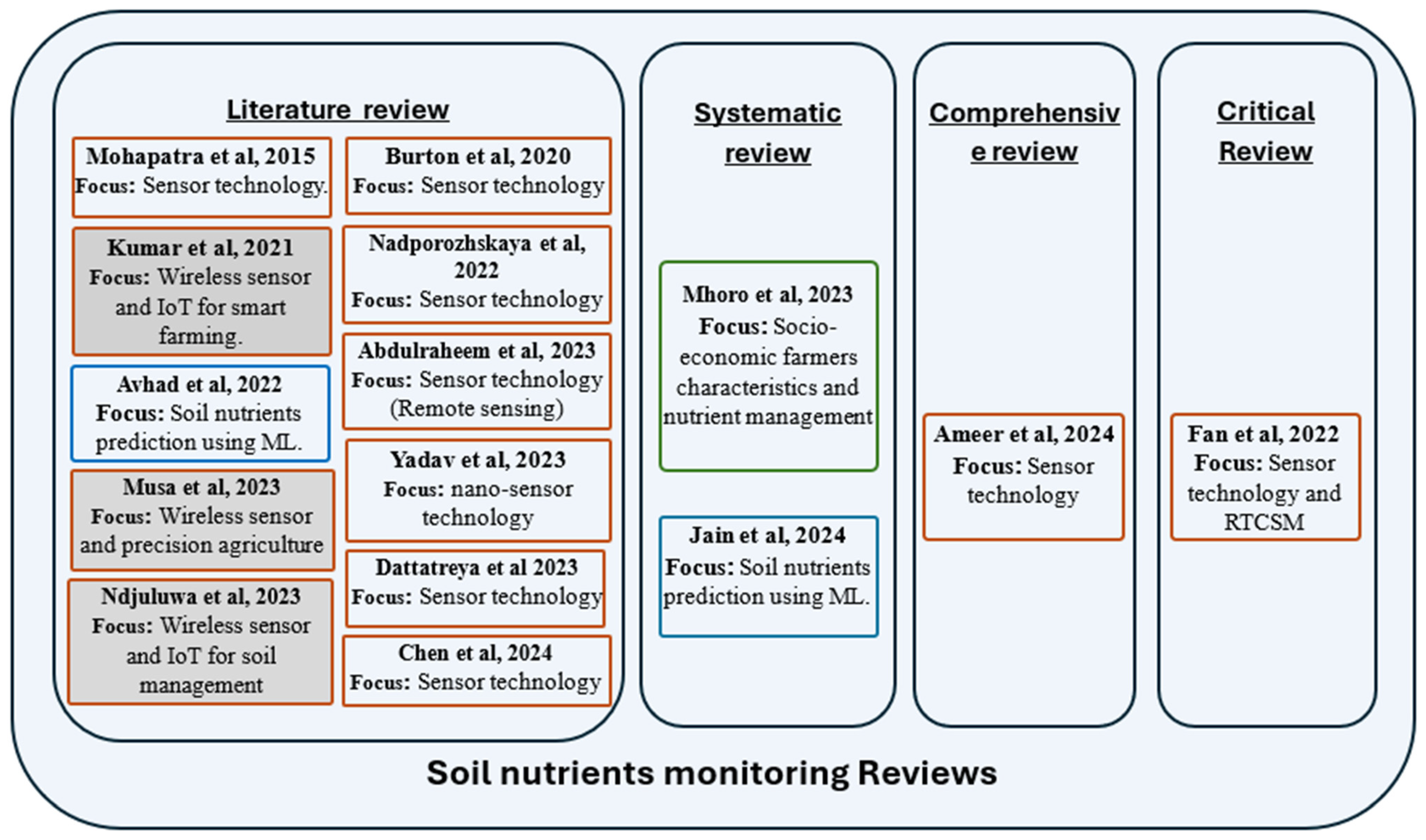
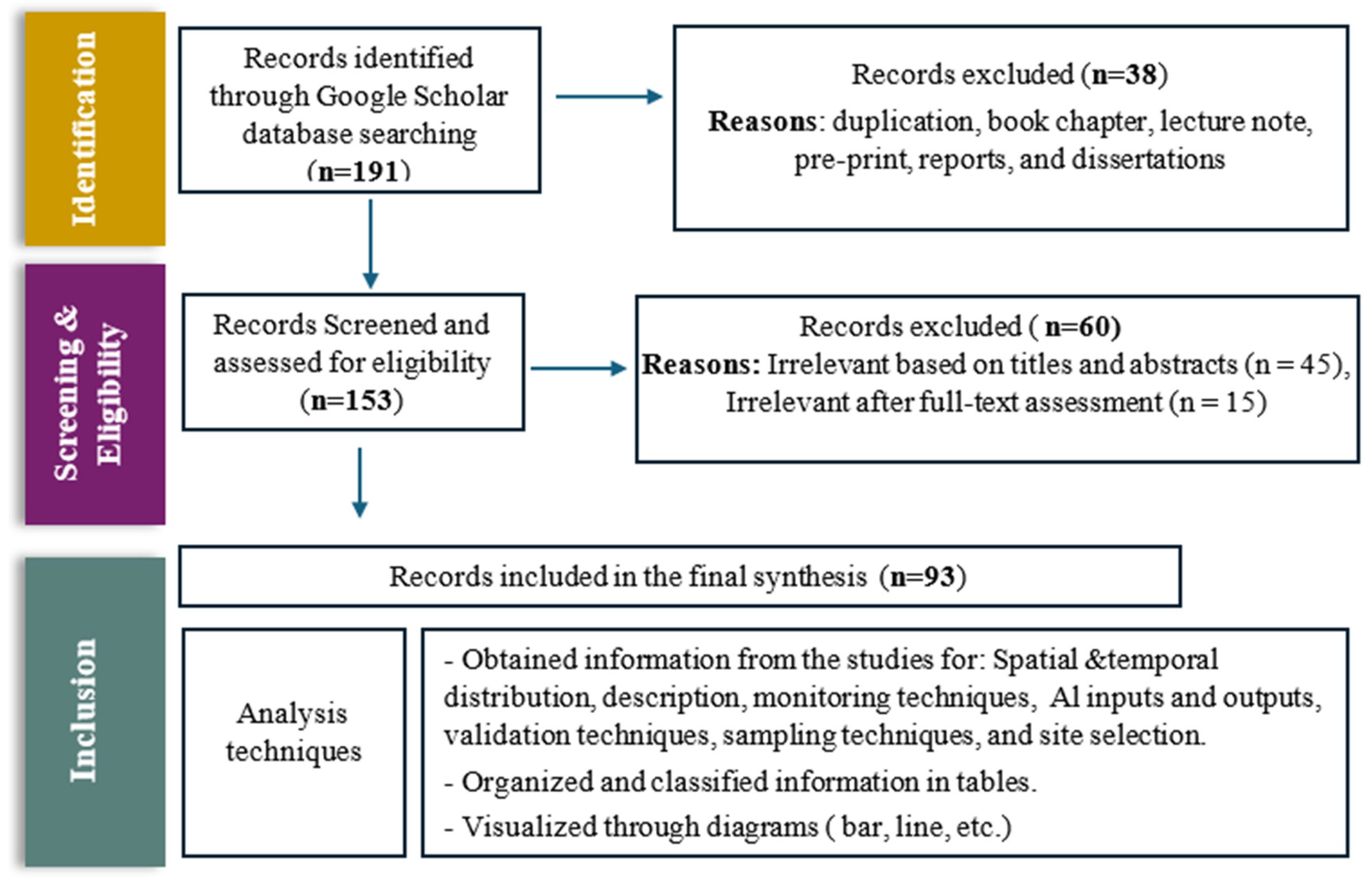
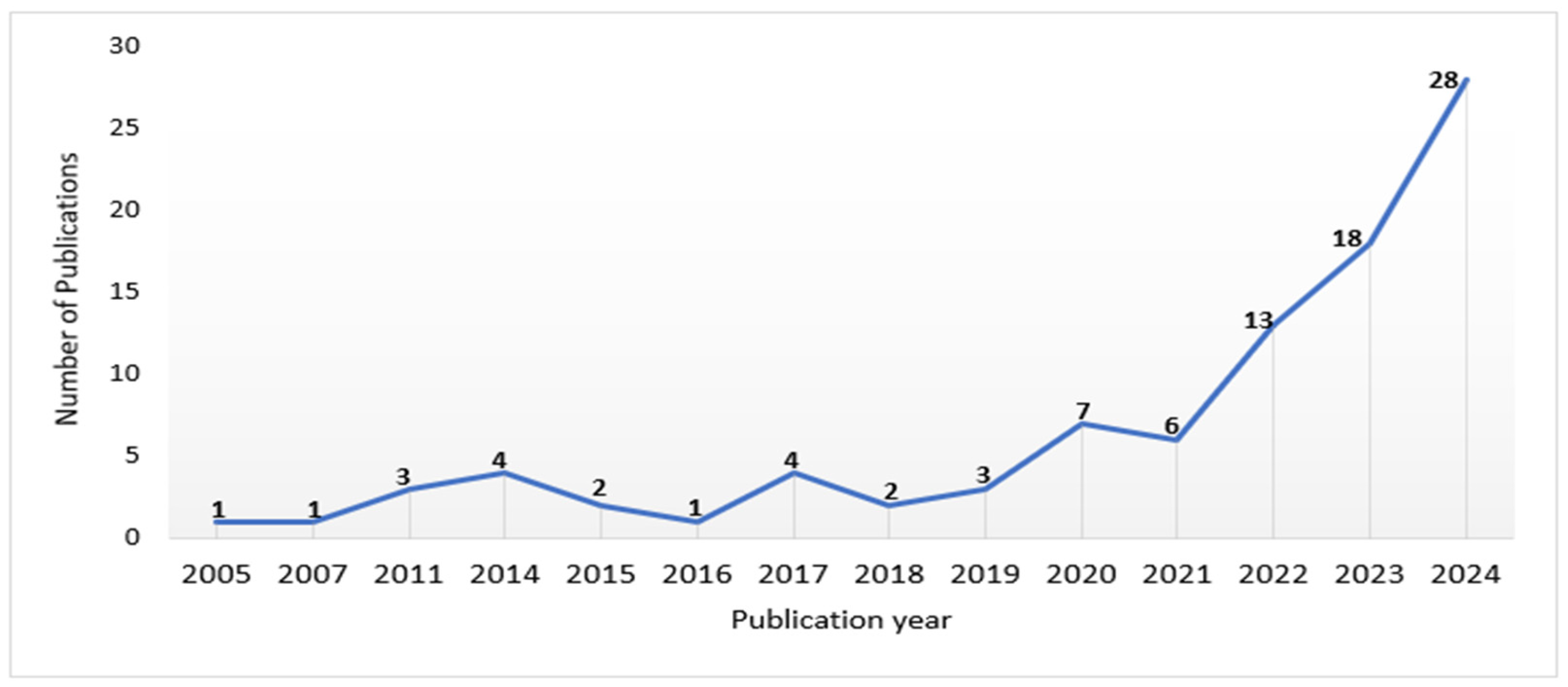


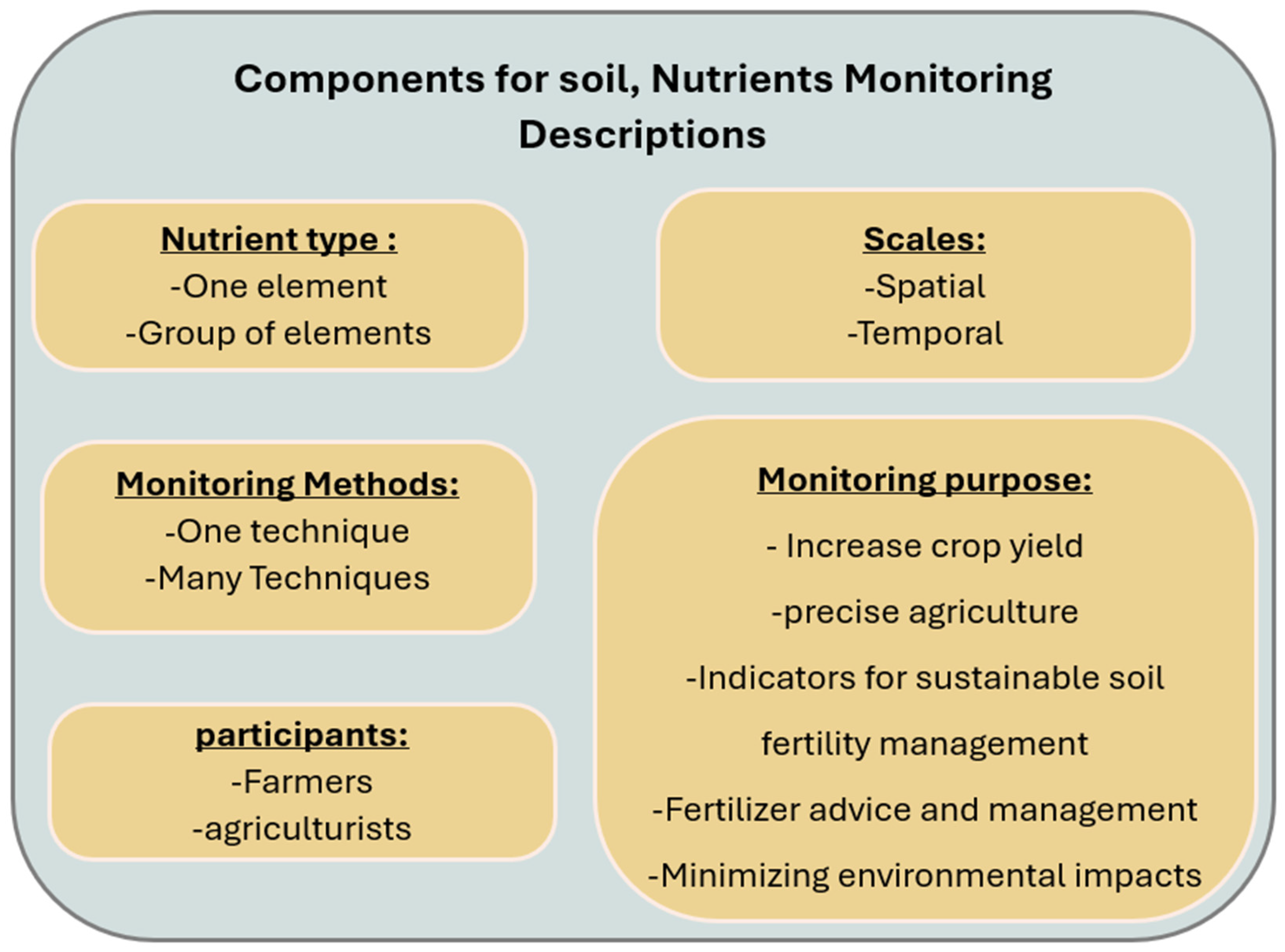
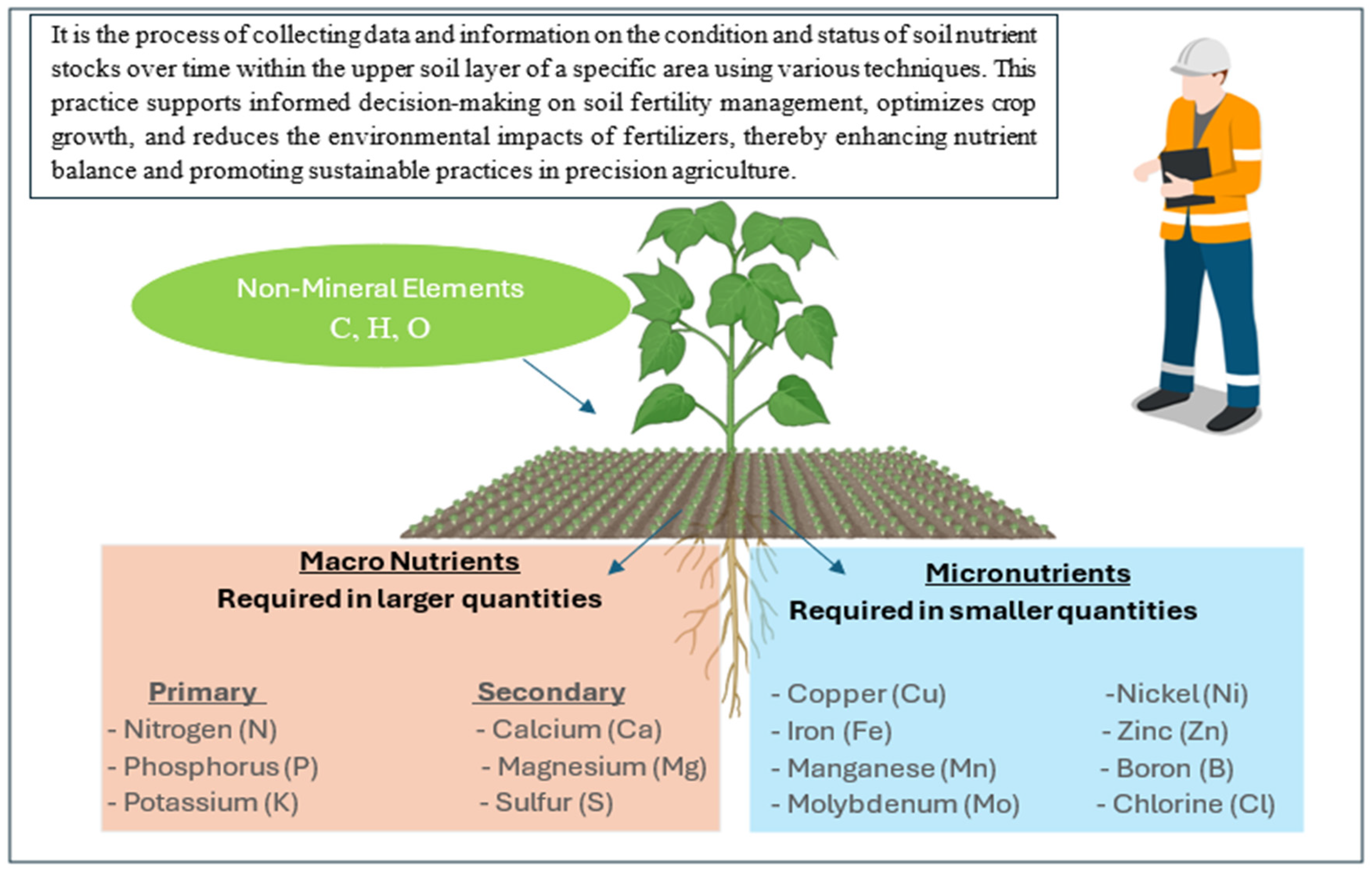
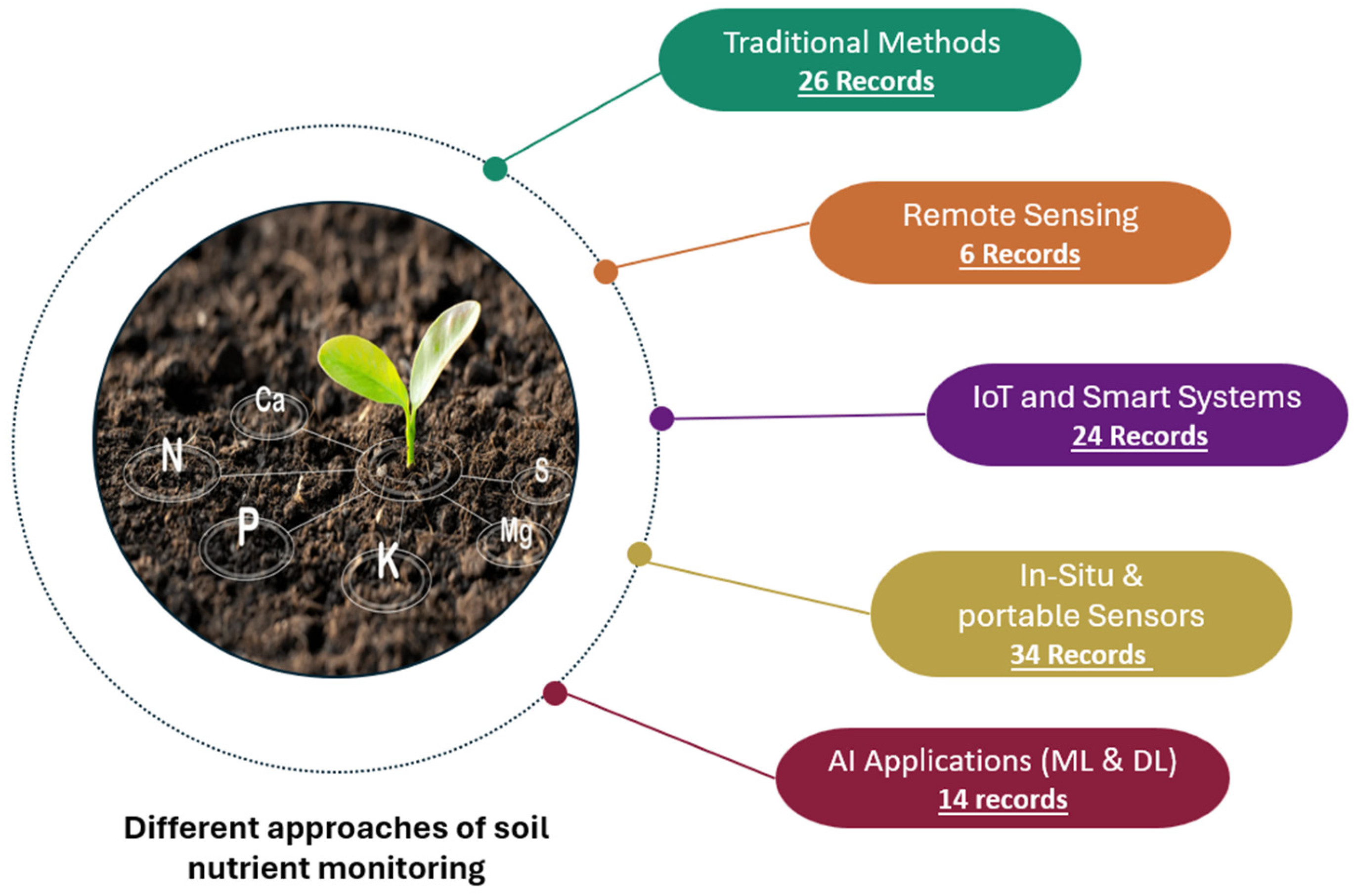
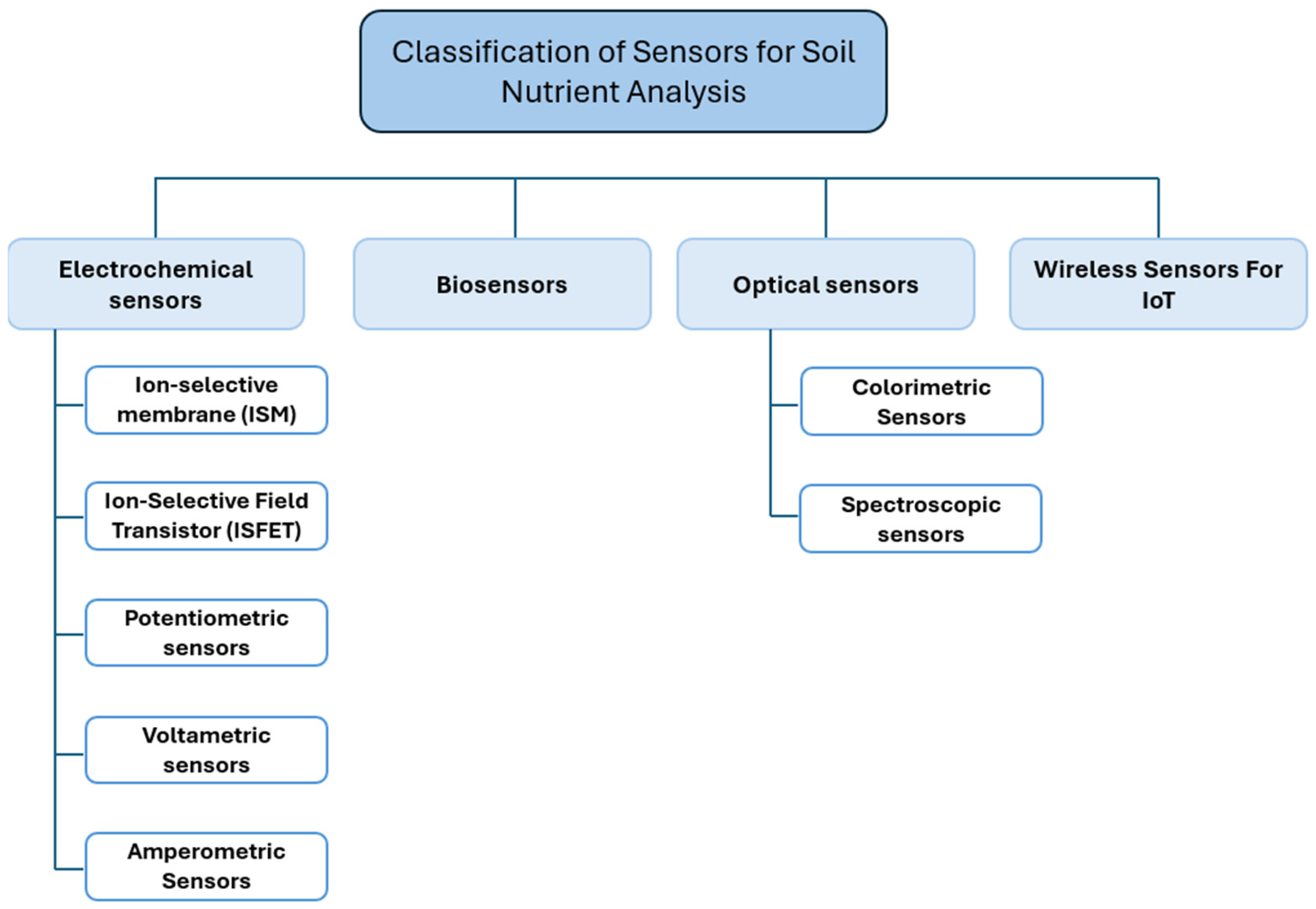
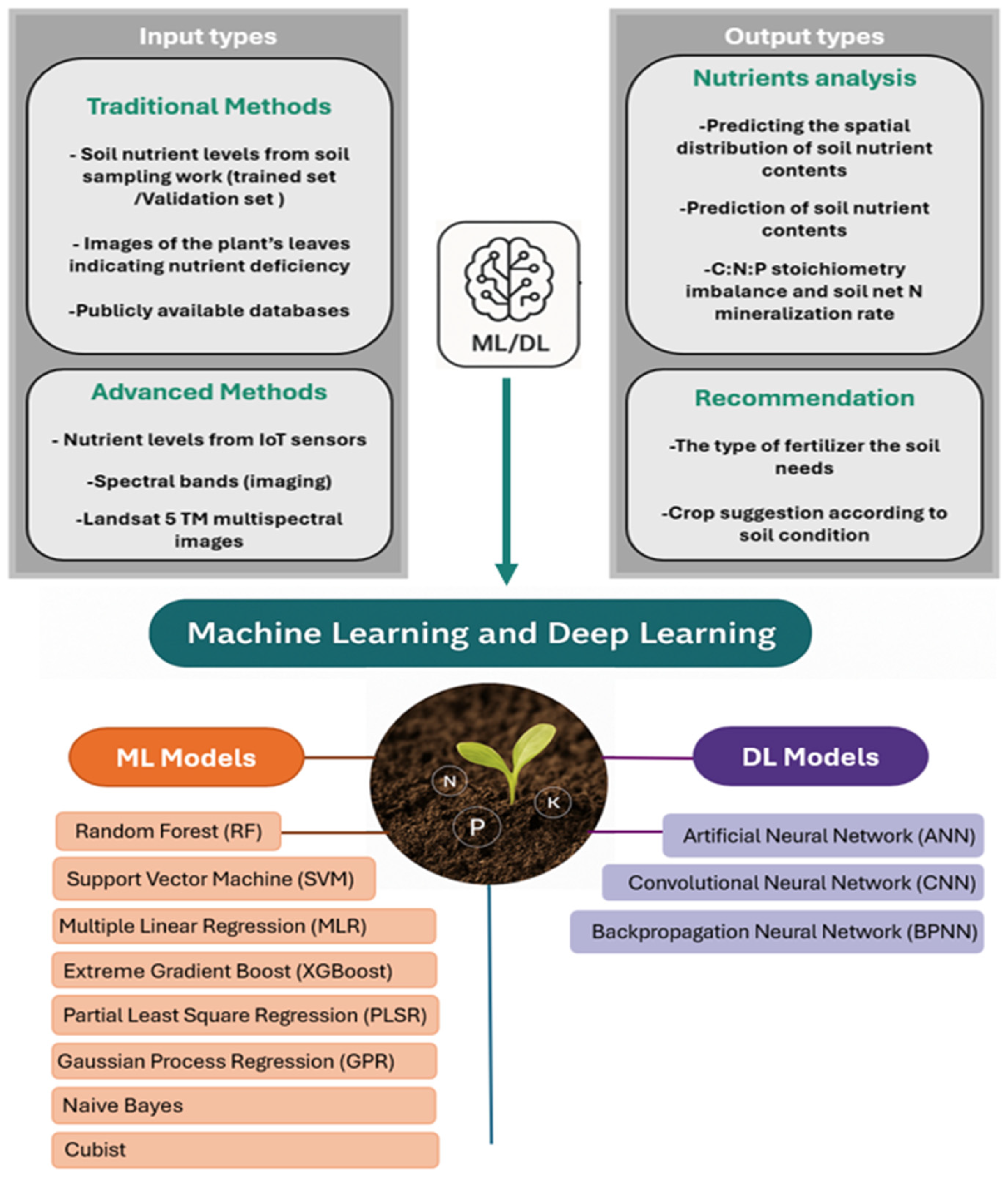
| S.N. | Definition or Description | Citation |
|---|---|---|
| 1 | The monitoring system provides farmers with valuable data about the soil’s condition, allowing for timely decisions regarding nutrient management and fertilization. Soil has three major nutrients: nitrogen (N), phosphorus (P), and potassium (K), which are represented as NPK. | [30] |
| 2 | Soil nutrient monitoring can provide valuable indicators for sustainable soil fertility management by linking nutrient balances and soil nutrient stocks. | [39] |
| 3 | Monitoring soil nutrient levels is essential for the effective utilization of fertilizers and the mitigation of the ecological footprint resulting from fertilization techniques. | [32] |
| 4 | The soil nutrient monitoring system is to master the nutrient status of the bare ground and quickly extract information on farmland nutrients which are categorized into macronutrients required for sustained plant health such as Nitrogen (N), Potassium (K), Phosphorus (P), Carbon (C), Hydrogen (H), Oxygen (O), Calcium (Ca), Magnesium (mg), and Sulfur (S), and micronutrients also essential to plant development and growth such as Chlorine (Cl), Iron (Fe), Boron (B), Manganese (Mn), Zinc (Zn), Copper (Cu), Molybdenum (Mo), Sodium (S), Silicon (Si) and Nickel (Ni). | [35] |
| 5 | The monitoring of levels of soil nutrients can be utilized by farmers, agriculturists, and soil enthusiasts, and this information is used in terms of future trends and application of the appropriate amount and type of fertilizers needed to ensure optimal plant growth and increased crop yield. Monitoring and detecting levels of soil macronutrients (i.e., nitrogen, phosphorus, and potassium) are vital in the practices and guidelines on sustainable farming and implementation. | [40] |
| 6 | Soil nutrient monitoring is explained as the Nutrient Expert tool (IoT) and is highlighted for its role in efficient crop nutrient management, leading to increased yields, farmer income, and reduced greenhouse gas emissions, thereby addressing the impacts of climate change. | [41] |
| 7 | Soil nutrient concentration can be monitored by IoT, as nutrients play a vital role in the growth and nourishment of the plant. Measurements of nutrients will allow us to know about the constituents of the nutrients present in the soil and the nutrients lacking in the soil. | [15] |
| 8 | Soil nutrient status can have a direct impact on the success and speed of rehabilitation of cut slopes. As one of the important soil nutrients, soil phosphorus (P) can potentially limit successful rehabilitation of cut slopes, play an important role in soil nutrient cycling, and is a potentially significant determinant of soil quality. | [37] |
| 9 | The soil nutrient monitoring system is used to master the nutrient status of the bare ground and quickly extract information on farmland nutrients. Because it has a significant impact on crops, soil nutrient monitoring is important. | [36] |
| 10 | Nutrient management, based on the best available information for soil test targets, a greater understanding of fluxes of nutrients on farms, and potential nutrient loss processes and pathways, will lead to improved nutrient efficiency on farms and hence the best return on fertilizer investment, as well as reduced risk of losses of nutrients to the environment. Assessment of N, P, K, and S fertility status by soil testing is now widely accepted and is a major tool in providing fertilizer advice for crops and pasture. | [38] |
| 11 | Soil nutrient monitoring is a critical aspect of modern agriculture, and biosensors offer a promising solution to this challenge, which have the capability to detect and quantify essential nutrients such as nitrogen, phosphorus, and potassium in the soil. By providing real-time data on nutrient levels, biosensors enable farmers to implement site-specific fertilizer application strategies. | [42] |
| 12 | Sensing the changes in the nutrient ion concentrations is vital for providing the nutrient-sufficient conditions for maximal plant growth and yield. Therefore, a soil nutrient sensor is important for optimizing nutrient management. The detected ions contain the most important elements for plant growth, such as Nitrogen (N), Phosphorus (P), and Sulfur (S). | [43] |
| 13 | This real-time monitoring by Hyperspectral remote sensing can quickly assess and monitor crop nutrient levels and soil nutrient content. Technology can provide an important basis for the rational application of nitrogen during fertilization. | [44] |
| 14 | Monitoring soil conditions (e.g., moisture, nutrients, and pollutants) over growing seasons enhances resource efficiency, ultimately leading to maximized agricultural yields while simultaneously minimizing environmental impacts. | [25] |
| 15 | Soil nutrients are an important factor in measuring soil fertility, and traditional farm management and agricultural systems have led to polarization of soil nutrients in farmlands. (Soil nutrients’ importance.) | [45] |
| 16 | Soil nutrient monitoring, especially for nitrogen, is essential for understanding nutrient dynamics and enabling timely management. | [46] |
| 17 | Soil nutrient monitoring involves resin-based measurements using Plant Root Simulator (PRS) probes to track nutrient availability in soil, particularly for nitrogen (N), calcium (Ca), and sulfate (SO4) levels. This approach allows for analyzing changes in nutrient levels resulting from different forest management treatments and understanding the nutrient dynamics. | [47] |
| 18 | Soil nutrient monitoring is essential for precision agriculture, aiming to optimize fertilization and crop yield. | [48] |
| No | Type of Sensor/Probe | Sensor Measurement | Citation |
|---|---|---|---|
| 1 | Electrochemical sensors (3Printed sensors) | NPK | [76] |
| 2 | Electrochemical Sensors | NPK, pH, Carbon, moisture | [71] |
| 3 | Biosensor | NPK, EC, | [27] |
| 4 | Optical sensors (color sensors) | NPK | [49] |
| 5 | Optical sensors (color sensor) | pH and NPK, Moisture, Temperature | [28] |
| 6 | Wireless Sensor | Nutrient and pH levels | [64] |
| 7 | Printed Potentiometric sensor | Nitrate | [77] |
| 8 | Wireless Sensor Network | NPK | [62] |
| 9 | Ion-selective sensor | NPK | [48] |
| 10 | - Optical sensor (Vis-IR, ATR, and Raman spectroscopy) - Electrochemical sensors (ISFET’s, ISE’s) | NPK, continue nutrient monitoring | [20] |
| 11 | Optical methods (colorimetric, spectroscopic) Electrochemical methods (Ion Selective Membrane (ISM), Ion-Selective Field Transistor (ISFET) Conductivity electrodes | NPK, pH, temperature, and moisture | [26] |
| 12 | PRS (Plant Root Simulator) TM probes | Nitrogen | [78] |
| 13 | The 3D Electrospray sensor (Potentiometric solid-state ion-selective membrane (ISM) | Soil Nitrogen | [46] |
| 14 | Electro-Chemical Sensing (ISE sensors) | Nitrate | [79] |
| 15 | ISFET electrochemical microsensors | Nitrate, ammonium, pH | [80] |
| 16 | Printed soil sensors using electrochemical sensing mechanisms (Potentiometric sensors, Voltametric Sensors, Amperometric Sensors) | NPK, Cd, Pb, Cu, Hg | [25] |
| 17 | Electrochemical sensing methods | NPK | [7] |
| 18 | Wireless sensor networks (WSN) | Soil moisture and nutrients | [30] |
| 19 | In situ Soil NPK sensor | NPK | [81] |
| 20 | ISFET (Ion Sensitive Field Effect Transistor) | The sensing elements are K+, NO3−, H2PO4− as well as pH | [82] |
| 21 | Optical sensors | Nitrogen | [83] |
| 22 | - Electrochemical sensors (ISE, ISFET) - Spectroscopic sensors (UV–Vis spectrophotometry - Raman, and infrared, and biosensors. - Electrochemical sensors exhibit | Nitrite and nitrate | [84] |
| 23 | Optical chemical sensor | Nutrients | [75] |
| 24 | 1-Sensors using optical principles 2-Sensors using electrical conductivity | NPK, EC, moisture | [19] |
| 25 | Wireless Sensors | NPK | [32] |
| 26 | Chemical Sensors | Soil pollutants, nutrients, moisture, and temperature | [21] |
| 27 | Electrochemical sensors | NPK | [85] |
| 28 | Biosensor | Soil health, moisture, temperature, and metals | [42] |
| 29 | Color Sensor | NPK | [86] |
| 30 | Ion-selective field-effect transistors (ISFETs) offer potential as micro-sensors | NPK and soil moisture monitoring | [87] |
| 31 | Ion-selective electrode (ISE) | Phosphate | [88] |
| 32 | Electrical conductivity-based sensors | NPK | [89] |
| 33 | Potentiometric ion sensors | Potassium ion | [90] |
| 34 | Electrophoresis-based Microfluidic ion nutrient sensor | Chloride, nitrate, sulphate, and dihydrogen phosphate | [43] |
| No | Type of Al (ML/DL) | Algorithms/Models Used | Input Data/Source | Output/Prediction Target | Citation |
|---|---|---|---|---|---|
| 1 | ML | RF, KNN, SVM, Naive Bayes | Soil samples (NPK, pH by colorimetry) | Nitrogen, Phosphorus, Potassium, and Soil pH Prediction | [71] |
| 2 | DL | CNN | Images of maize leaves (nutrient deficiencies) | Type of nutrient deficiency in maize leaves | [28] |
| 3 | ML | MLR | Soil nutrient results from the near-infrared spectroscopy | Building a soil nutrient information extraction model | [91] |
| 4 | ML | RF, SVM, MLP | Soil images (analyzed for NPK content) | Fertilizer recommendation, nutrient requirement prediction | [26] |
| 5 | ML | RF, Logistic Regression, SVM, | Field sensor data (NPK, pH, rainfall, temperature, crop) | Fertilizer recommendation | [67] |
| 6 | ML | RF, XGB, MLR, decision tree | NPK, PH, temperature, humidity | Crop recommendation | [53] |
| 7 | ML/DL | SVR, PLS-ANN, GBRT, Cubist PLSR, BPNN, GPR, | Spectral bands/imaging | Nutrient estimation | [9] |
| 8 | DL | ANN | Soil samples to represent the nitrogen application rate (F) | Prediction of soil urea conversion | [92] |
| 9 | ML/DL | PLSR, BPNN, SVM | Soil sampling + Landsat 5 TM multispectral images | Spatial distribution of soil total nitrogen | [45] |
| 10 | ML/DL | SVM, RF, CNN | Custom crop dataset (NPK, S, Fe, Zn, temp, rainfall, pH) | Crop recommendations | [93] |
| 11 | ML/DL | ADABOOST, MLR, CNN, SVR | Soil samples’ spectral data | Organic Matter, P, K prediction | [94] |
| 12 | ML | Gradient Boosting Classifier | Soil nutrition, pH, and weather | Fertilizer recommendation | [72] |
| 13 | ML | RF, SVM, XGB, GBDT (GBRT) | Meteorological, soil physical/chemical parameters | C: N P imbalance, soil net N mineralization rate | [10] |
| 14 | ML/DL | MLR, ANN | Soil samples + satellite imaging | Total potassium prediction | [50] |
| No | Validation Techniques | Citation |
|---|---|---|
| 1 | Machine learning Help assess the prediction accuracy of the models: - Root Mean Squared Error (RMSE): - Ratio of Performance to Deviation (RPD): - Ratio of Performance to Inter Quartile Distance (RPIQ): - Mean Absolute Error (MAE): - Mean Squared Error (MSE): - Coefficient of Determination (R2): | [9,10,11,45,50,52,58,65,94] |
| 2 | Cross Validation Dividing the dataset into training data and testing data. Divided into three parts: 70% for training, 15% for testing, and 15% validation | [11,28,48,50,71] |
| 3 | Ground Validation Ground validation via field sampling and laboratory analysis is often necessary to calibrate and validate remote sensing data by taking direct measurements at specific locations, ensuring its accuracy and speed, and double-checking everything to ensure the remote sensing technology is reliable | [24,61] |
| 4 | Standard soil chemical properties were provided by trusted centers or institutions | [96] |
| Sampling Methods | Related Monitoring Technique | Sampling Techniques, Size, and Location | Citation |
|---|---|---|---|
| Random sampling | Traditional | In total, 12 Random sampling: Soil samples were collected for the four different rehabilitation ages: 1 year (1a), 3 years (3a), 5 years (5a), and 11 years (11a). Sampling location 1: Log 32°46′41″ N latitude 103°38′27″ E. Altitude 3050.15 m. Location 2: Log 32°46′48″ N latitude 103°37′17″ E Altitude 3000.67 m. Location 3: Log 32°49′4″ N latitude 103°39′51″ Altitude E 3110.38 m. Location 4: 32°47′39″ N 103°35′7″ E 3030.20 m. | [37] |
| Random 30 points were generated using ArcGIS, with a minimum for the traditional monitoring method. | [97] | ||
| A total of 588 soil samples were collected at a depth of 0 to 22.5 cm from the sampling location: between 21.54296910° N and 74.44691462° E. | [98] | ||
| (IoT)+Sensors | In total, 24 for analysis, a few samples: GPS coordinates of [−7.97918385, 110.946764], [−8.06634869, 110.879614], [−8.03665317, 110.879614], and [−8.0366279, 110.884316]. | [65] | |
| Electrochemical sensors | Random selection | [85] | |
| Remote sensing | Three 1 m × 1 m plots were randomly selected to understand the long-term grazing impacts on the soil. The sampled soil from sampling sites was collected at different distances (at 0, 300, 600, 900, 1200, and 1500 m). | [58] | |
| Transects | Traditional | Four altitudinal transects, four sampling locations along each transect. Half of the sampling sites were located in cultivated land, and half were in uncultivated land—either fallow land or grassland. Sampling Location: at 37°25′18.9″ East, 11°21′44.1″ North. | [57] |
| Two 20 m transects, 12 soil samples were collected at each site. | [99] | ||
| Machine learning and traditional | In total, 210 soil samples were collected along a 3500-km transect; the sites were carefully selected, considering topography, climate conditions, crop types, cultivation practices, and local agricultural management policies. | [10] | |
| Quadrat | Traditional and remote sensing | In total, 27 sampling quadrats were deployed for field SAN (soil available nutrients). Each quadrat had an area of 30 m × 30 m, and three sampling points were selected along the diagonal of each quadrat. | [52] |
| Grid | Sensor | Grid sampling, with 2 km × 2 km grid size, was adopted for the collection of soil samples. | [50] |
| ML and T | A total of 800 soil samples were collected in the experimental area, and a 5 km grid was set as the sampling unit. Sampling study area: (Site 1 is located between40°04′–39°36′ N and 78°38′–79°50′ E. Site 2 range between 44°25′–44°27′ N and 85°40′–86°10′ E. Site 3 extends from 46°31–46°37′ N and 83°37′–83°41′ E.). | [94] | |
| Real-time sensors and traditional | A total of 145 soil samples were collected at a 0–20 cm depth. Samples were collected at 50 m × 50 m grid sampling points. | [11] |
| No | Site Selection | Citation |
|---|---|---|
| 1 | The sampling locations were specified as four different 4-cut slopes in the mountains of Southwest China, corresponding to different rehabilitation ages: 1 year (1a), 3 years (3a), 5 years (5a), and 11 years (11a). | [37] |
| 2 | Half of the study sampling sites were located on cultivated land, and half were on non-cultivated land. | [57] |
| 3 | Sites were located on sand dunes, with soil types ranging from loose, loamy, quartz sands to sandy clay loams. | [99] |
| 4 | The site selection considered topography, climate, and soil type. Clay loam soil is typical of rice agriculture areas. | [85] |
| 5 | This is a forest farm area used for various experiments. | [60] |
| 6 | Due to historical land use, semi-arid soils commonly experience degradation, which leads to low levels of soil organic carbon (SOC) and poor structure. | [70] |
| 7 | This area is characterized by relatively high terrain, and the land use is cropland with corn, buckwheat, and flue-cured tobacco as the main crops. | [11] |
| 8 | The study included two types of agricultural land use (rice paddy field and vegetable field). Sites were carefully selected, considering topography, climate conditions, crop types, cultivation practices, and local agricultural management policies. | [10] |
| 9 | Soil sampling was restricted to the dry season to limit the impact of soil moisture on the satellite remote-sensing spectrum. | [50] |
| 10 | Sampling soil from sampling sites at different distances from the pens, to gain information about the longer-term impact of grazing on soil. | [58] |
Disclaimer/Publisher’s Note: The statements, opinions and data contained in all publications are solely those of the individual author(s) and contributor(s) and not of MDPI and/or the editor(s). MDPI and/or the editor(s) disclaim responsibility for any injury to people or property resulting from any ideas, methods, instructions or products referred to in the content. |
© 2025 by the authors. Licensee MDPI, Basel, Switzerland. This article is an open access article distributed under the terms and conditions of the Creative Commons Attribution (CC BY) license (https://creativecommons.org/licenses/by/4.0/).
Share and Cite
Sobhy, D.M.; Anandhi, A. Soil Nutrient Monitoring Technologies for Sustainable Agriculture: A Systematic Review. Sustainability 2025, 17, 8477. https://doi.org/10.3390/su17188477
Sobhy DM, Anandhi A. Soil Nutrient Monitoring Technologies for Sustainable Agriculture: A Systematic Review. Sustainability. 2025; 17(18):8477. https://doi.org/10.3390/su17188477
Chicago/Turabian StyleSobhy, Doaa M., and Aavudai Anandhi. 2025. "Soil Nutrient Monitoring Technologies for Sustainable Agriculture: A Systematic Review" Sustainability 17, no. 18: 8477. https://doi.org/10.3390/su17188477
APA StyleSobhy, D. M., & Anandhi, A. (2025). Soil Nutrient Monitoring Technologies for Sustainable Agriculture: A Systematic Review. Sustainability, 17(18), 8477. https://doi.org/10.3390/su17188477






